We used mixed methods to understand human-nature interactions in Kasungu, Malawi. We specifically examined people's use of natural resources and perceptions of wildlife conservation and their implications for livelihoods and conservation.
Over 90% of participants reported collecting natural resources such as firewood, grass, medicinal plants and fruits to support their livelihoods. While most resources were collected for household use, some served both income generation and domestic purposes. Kasungu National Park plays a critical role in providing resources, though harvesting is illegal, alongside neighbouring farms and community forests. Households near the park, women and those of lower economic status were more likely to rely on the park for resources. Additionally, crop and livestock loss experiences were linked to higher resource collection rates.
Participants generally expressed positive attitudes towards wildlife and conservation. However, certain factors including proximity to the park, women, food insecurity, and crop and livestock loss were linked to negative attitudes.
Our findings offer valuable insights for the design and implementation of conservation initiatives and policies, particularly in communities heavily dependent on natural resources for their livelihoods. Conservation programmes and policies around protected areas should capitalise on the existing positive attitudes towards nature by fostering better community engagement. Locally led, inclusive and nature-positive programmes could simultaneously benefit conservation efforts and improve livelihoods.
DOI:
https://doi.org/10.1002/pan3.70008Dimensiones Recuento de citas:
Año de publicación
2025
Autores
Mandoloma, L.; Clark, M.; Coad, L.; Hughes, K.; MilnerGulland, E.J.
Idioma
English
Palabras clave
conservation, natural resources management, livelihoods, food security, protected areas, community involvement, human-nature interactions, wildlife conservation
Geográfico
Malawi

















